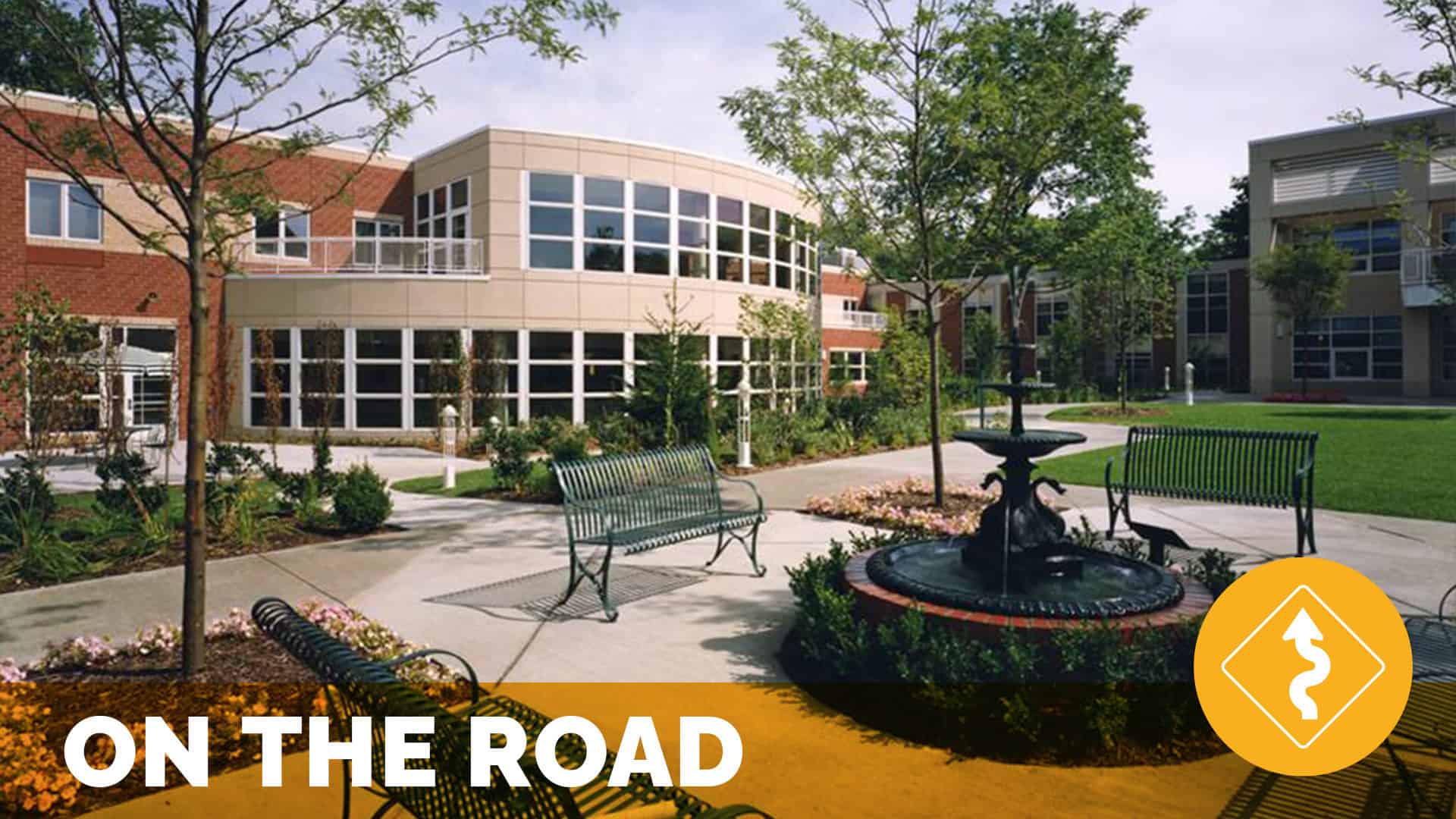Experience Excellence Across the Continuum of Care

On the Road with The New Jewish Home – June 2017
by Jason A. Wolf, PhD, CPXP
Our latest On the Road took us to New York and an innovator in the long-term care segment of healthcare, The New Jewish Home (TNJH). TNJH has also emerged as an organization committed to the experience of those it serves. In the environment they serve this could include a range of services from rehabilitation, to assisted living, home health, to nursing homes, and covers a service based on individuals called patients, clients, elders, residents and more. The richness and breadth of offerings provided in the TNJH system exemplifies how a focus on experience can be a connecting point among distinct efforts. In fact, TNJH was the first organization I know of in long term care to name a Chief Experience Officer, Tammy Marshall. Tammy served as my host on this quick trip through the system as we travelled among various sites. It is also fair to say that in an organization of this scope and size my visit only began to scratch the surface of what TNJH is aspiring to achieve in a segment of healthcare where experience has not always been top of mind. It is clear TNJH is working to show it can be done differently.
Starting with Skills
As TNJH took on the effort to address the experience of those it serves it realized a fundamental commitment was to ensure the people providing care needed to have a foundational understanding of and the support skills needed to achieve excellence in experience. With an unwavering objective outlined by CEO, Audrey Weiner, to create a “Best in Class” Culture & Elder Experience that transforms The New Jewish Home Culture from the inside-out, it was clear there was a need to start with the people of TNJH first.
This decision led to the development of and engagement in an effort dubbed The New Jewish Home Empathy & Hospitality Platform. It has been a focused effort to not only understand the cultural objectives of what TNJH aspires to be as an organization, but providing the core skills needed to realize those results. In partnership with an organization called Just Think Hospitality, TNJH set out on an effort to provide learning around empathy and hospitality. A central focus of this work has been to provide every TNJH employee exposure to learning on leading with empathy in 2017, around 2500 employees in total.
As Tammy Marshall described it, the intent of the program is to introduce employees to the “Experience Era”, describe the intersection between health care and hospitality, and provide the skills and tools needed to create a “warm welcome”, that “something special” in the middle, and the “fond farewell.” What I saw as significant to this effort was the organization’s commitment to have everyone engaged in the process of learning from the board of directors to those on the front line of care. Creating a shared understanding of the core ideas and skills is serving as a means to create a common approach to addressing experience that still meets the client where they are.
At the heart of this process are four key points that everyone in the organization could use as a framework for how they engage with those they serve. Simple in concept, these four actions represent the behaviors and practices that will support TNJH in bringing best in class care and experience to life. They include:
- Inform Me. Which includes setting clear expectations, anticipating needs questions, concerns, and communicating in plain language
- Know Me. Which includes knowing beyond my medical records to my life history, manage transitions and addressing me where I am
- Ask Me. Which includes asking how I prefer to receive information, engaging in understanding my expectations when I arrive and gather my feedback when I leave
- Care for Me. Which includes understanding my personal needs and caring for those directly from managing pain to dietary, clinical and/or social needs.
In working to bring the idea of hospitality and empathy to TNJH I asked Tammy what she hoped they would achieve. Her response gets at the heart of an opportunity we all have in healthcare in moving to an environment of partnership and managing the balance of care between those we serve and those who serve. She offered a powerful reflection, “Our philosophy of care is Person Directed Care, that is the degree to which we deeply listen to our clients, will reflect and be in direct proportion to the degree in which we can meet their physical, emotional and spiritual needs. The desire is for our employees to feel connected to each other, the clients and the brand so that we can deliver our brand promise of creating meaningful experiences for clients wherever they call home.” And it is clear in my time with TNJH that the idea of home is more than just part of their name, but something they strive for in every action they take.
Striving for Consistency in a World of Variation
During my travel around the system I had the chance to speak with numerous people and even meet a few clients and residents along the way. I was able to spend time learning about TNJH core clinical skilled nursing facility in Manhattan, spent time visiting both Senior and Assisted Living offerings in the Bronx and had the chance to experience the new Small House model in Westchester. I offer a few reflections on each of these for their distinctions and their connections.
Connecting to the Person – Manhattan Campus
I was able to spend some time with Marie Rosenthal, Administrator for the Manhattan Division of TNJH. In many ways our visit and conversation exemplified the broader intent I felt and experienced from the organization overall. As I asked Marie about her hope to a focus on experience she relayed an idea I found central to many of my interactions across the organization, offering, “Only when we as clinicians realize our success depends on the people that use our services, is when we can succeed.” This represents the very ideas outlined in the learning TNJH was taking on. That meeting people where they are must be central to any care experience and in fact Marie, who started her healthcare career in the acute world reinforced it may be that much more important in the long term care setting.
She suggested that in order to be successful, not only in the clinical offerings of the Manhattan campus, but across the organization there needed to be a shift from operating from a purely clinical mindset to one that understood the value and importance of the relationships and experience created. She offered that creating excellence in experience meant connecting to the person and meeting them where they are. This includes knowing who they are and what makes them tick, understanding what brings them joy or a sense of comfort and even such basic issues as what they want to eat. In many ways these ideas are magnified in an environment where people will be spending long periods of time and perhaps even the rest of their time. She noted many people in our care don’t get to plan to be here, but one day here they are and their life may never be the same from that day forward. We have the important job of ensuring we honor who they were, are and want to be while we care for them.
She used the example of a 96-year-old woman in one of her units to make the point. Most would assume at 96 they would just follow the standard routine of care, wake, bathe, feed, etc., but she was active, wanted to be involved in her care and in activities, wanted to be moving, taking walks and doing things. At the same time, she loved her privacy and quiet times to herself. If standard practice were applied having this resident conform to the needs and processes of the organization they would completely miss the opportunity to meet here where she was, to honor and support her needs. But rather in taking the time to understand the person and offer the space and process to be who she was they dramatically altered her experience and her life. It is a subtle but significant action that we can take Marie offered and these are lessons we can share across all of healthcare.
Creating a space of care that feels like home – Kittay Senior Apartments and Assisted Living Program
While not all the work of long term care and TNJH is clinical, it still is committed to and honors the needs of those it serves. At its Bronx campus, this philosophy plays out in two connected but distinct settings. One a Senior Apartment setting where residents are just that, tenants that rent apartments, but have supporting services around them and the other Assisted Living in which more clinical care is available but still directly primarily by the residents themselves.
Both of these setting represent the breadth of scope faced in long term care organizations and reinforce the need for fundamental commitments and philosophies on experience that meet the needs of clients and residents wherever they happen to be on the continuum of care. In these environments responsiveness of staff, the ability to address complex family issues and ultimately the commitment to ancillary and support services all come to play. In the living environment, long term care also takes on the role of landlord to tenants and the additional dynamic this raises.
This shift the conversation in these environments from one about clinical processes to ensuring comfortable facilities, support services and perhaps the biggest opportunity providing food. In the Assisted Living environment Lisa Wacht offered that in addressing the diversity of residents we have has us be more intentional in both the activities we plan and engage in and the very food we offer or the varieties in which it must be prepared. On the residential side, Leslie Hoot offered the primary means they have in ensuring best in class service for residents is to give them a voice. “They are not just renters in our apartments”, she offered, “but we look to engage them so they feel listened to.” To do this the Kittay apartments has a Tenant Association where people can raise issues and opportunities to be addressed. This sense of ownership and engagement in how the organization runs, provides a sense of respect and engagement that reaches beyond a simple rental transaction. Rather it has allowed the staff to turn complaints or potential issues in to productive feedback and measured improvement. This example alone returns me to the statement Marie Rosenthal shared in Manhattan, in depending on those who engage in our services we see even greater results.
As I walked the halls of Kittay I was able to interact with a few of the residents, specifically Sister Loretta Theresa and Sister Maria Goretti, two members of the Franciscan Handmaidens of the Most Pure Heart of Mary. These incredible women, who have served as sisters for a majority of their lives, not only had incredible stories to share about their lives, but also were able to reflect on the focus and intentions of TNJH to meet the needs of all its residents. Some might wonder what sisters were doing living at The New Jewish Home, but what their current experience exemplified was that an organization committed to experience is more than a name or even its history, it is what it intends to be for those it serves every day and how it meets the needs of those individuals. As Sister Loretta and I held hands and laughed she reinforced something central to her faith that has been her core for most of her life. Fundamentally we are all human beings with experiences, perspectives and stories to tell. Her experience in living at TNJH has been grounded in that very idea. They honor the human, the person she is and her sisters are, and in doing so have provided a place in which they can live to who they are fully with the dignity and respect we would all hope to receive from others. Perhaps it is that concept that rests at the heart of the residential side of long term care and should remain an aspiration for all across the care continuum.
Bringing Community to Life – Small Houses at Sara Neuman Center
This commitment to meeting people where they are was underlined once more on my final stop to the Sara Neuman Center just outside New York City. A traditional nursing home in any regard, Sara Neuman has made a commitment to change the nature of the nursing home experience by implementing a Small House model. Small Houses are warm, inviting places that truly feel like home–because they are. These self-contained households are a transformation in thinking about long-term care–and an entirely new kind of nursing home.
Small House communities are inspired by the innovative Green House Project™ model where elders live in real homes rather than institutional environments, all while receiving the highest standards of skilled nursing care. Life in the Small House revolves around the needs and preferences of the residents, including sleep and resting cycles, activities and meals. Both privacy and the communal benefits of family life are key to Small House living.
As Tammy Marshall and I prepared to enter the first of the Small Houses I visited she paused to let me know prior to entering the Small Hose we needed to ring the bell and be invited inside. Much like you wouldn’t just walk into someone else’s home in this case you respectfully wait to be invited in. Once inside you find each Small House community is centered around a fully equipped kitchen where meals are prepared and shared at a communal dining table each day. Each Small House has its own trained and dedicated staff who provide daily care and get to know each resident personally so they can offer individualized care. Caregivers in the TNJH Small Houses are known as Adirim (Hebrew for noble), and do the cooking, housekeeping, and provide all the necessary supportive care of daily life. Medical, nursing and social work staff are available to fulfill clinical and medical needs when they arise.
While there is a commitment to experience in all TNJH does, it is hard not to see the incredible distinctions in moving from the Small House settings to the traditional nursing home environment at the Sara Neuman campus alone. What I found in the Small House setting in an inspirational and aspirational model that reflects the very four actions reflected in the training we discussed above. These environments reflect, live and breathe independence, individuality, community and home. If and when the time comes for me to engage in a facility such as this, a Small House, without question represents a place of dignity and respect, listening and meeting people where they are that reflects what I would want out of an experience. There is much we can and should learn from the commitments made and actions taken in this environment.
Returning to One Experience
The day after my visit through the TNJH organization I was honored to participate in the TNJH Management Retreat as we explored the “Power of &” in the healthcare experience. While I know the limited time I had with the people, patients and residents of TNJH only provided me a line of sight to just a sliver of all they do and how they do it, it reinforced an important point I have often stated, but had the chance on this visit to live directly. That experience matters at all touch points on the care continuum. That at each stage of healthcare whether we are there by choice or by need we should all expect, and I would add, all deserve to be treated as the individual human being we are. Meeting that need, desire and expectation should be much of all we aspire to as people working in healthcare every day.
This idea was reinforced in the commitments I heard emerge from the leaders of TNJH as I wrapped up my conversation with them that morning. Addressing experience is not always about, nor should it be only about the complex strategic efforts (though I believe it must be our strategic foundation in healthcare). Rather it takes each of us as leaders to make a single commitment to do something each and every day. Some of the commitments leaders shared where:
- Be more intentional in greeting people
- Engage in more client centered functions
- Get out of my office regularly to interact with the clients
- While not a clinician, I can stop to answer call bells
- Make the effort to volunteer my time for special events to connect more with those we serve
- Listen more to each other, my team and those we serve
While the list of ideas generated was much more extensive the general idea is reflected above. The things we do to provide the best in experience and for TNJH “best in class” are not about expensive investments or cumbersome actions, but rather by building on the small things each and every one of us can do each day to impact the life of the person in front of us, be they a colleague, patient or family member, resident or client. That is something my time at TNJH reminded me.
There is something profound about sitting with and seeing people at the latter parts of life’s journey. You can see their stories in their eyes, their joy in their smiles and even their fear in the squeeze of their hand. It puts your own humanity in perspective and reinforces above all else in a business of humans caring for humans we have no greater responsibility that to the individual and their needs right in front of us. That is our opportunity and that is our call. It is a challenge TNJH takes on every day and works tirelessly to ensure they achieve. And while they and none of us in healthcare can get it right all the time, we must never stop our efforts to ensure we provide the best for all those we work with and serve.
My greatest of appreciation to Audrey Weiner, Tammy Marshall and the entire team at The New Jewish Home, not only for an insightful and full visit, but for exemplifying a commitment to experience not just on the long term care end of the healthcare spectrum, but across the continuum, that we can learn from and be inspired by every day.
Related content
-
 Culture & Leadership
Culture & LeadershipCPXP Informational Webinar: Your Guide to the CPXP Credentialing Process (June 2025)
Complimentary – 12pm ET / 11am CT / 10am MT / 9am PT – Join us for an insightful informational webinar hosted by The Beryl Institute Credentialing team. In this session, we will walk you through everything you need to know about the CPXP (Certified Patient Experience Professional) credential, designed for human experience professionals. During
Learn more -
 Culture & Leadership | Patient Family & Community Engagement | Staff & Provider Engagement
Culture & Leadership | Patient Family & Community Engagement | Staff & Provider EngagementPX Chat: Leading with Pride – Navigating Patient Experience in Today’s Political Climate
2pm ET / 1pm CT / 12pm MT / 11am PT – Join us for a special PX Chat hosted by The Beryl Institute, created specifically for members and allies of the LGBTQ+ community working in patient experience. This virtual gathering is a dedicated space to connect, reflect, and support one another as we navigate
Learn more -
 Culture & Leadership | Patient Family & Community Engagement
Culture & Leadership | Patient Family & Community EngagementNational Human Experience Movement Led by SOBREXP in Brazil
Global Headliner Webinar Series (Complimentary) – Join this webinar to discover the inspiring journey of Brazil’s National Movement in Human Experience, led by SOBREXP, the Brazilian Society of Patient Experience and Person Centered Care. Learn about the timeline, strategies, challenges, and key achievements that have shaped this groundbreaking effort to elevate the human experience. Tuesday,
Learn more
